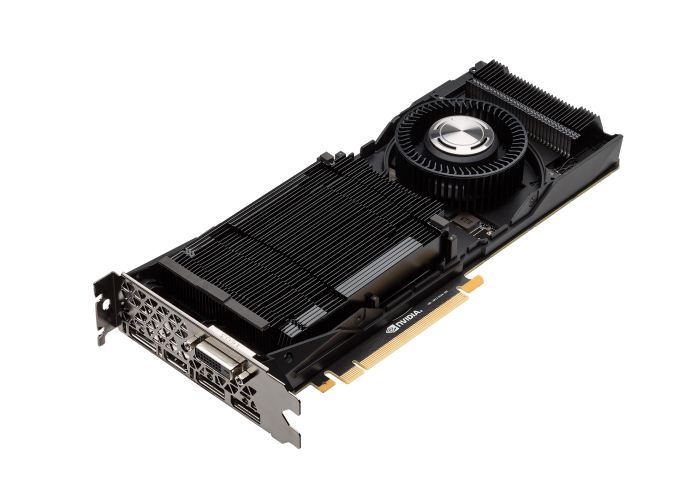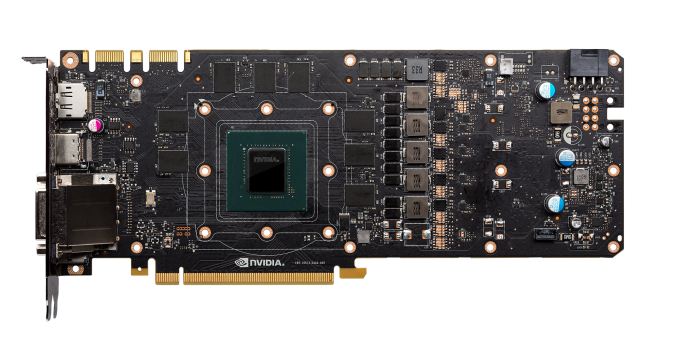The NVIDIA GeForce GTX 1070 Ti Founders Edition Review: GP104 Comes in Threes
by Nate Oh on November 2, 2017 9:00 AM EST- Posted in
- GPUs
- GeForce
- NVIDIA
- Pascal
- GTX 1070 Ti
Meet the GeForce GTX 1070 Ti Founders Edition
For the GeForce GTX 1070 Ti Founders Edition, pinned at the official MSRP of $449, NVIDIA has essentially plopped the GTX 1070 Ti GPU into a GTX 1080 board. This makes a lot of sense considering that this late-cycle card has the same GPU and 180W TDP requirements of NVIDIA's GeForce GTX 1080. Doing so allows NVIDIA to drop in the new specification and go with minimal changes, and similarly, their partners can take their own GTX 1080 designs and quickly reconfigure them for the GTX 1070 Ti.
The end result of this decision is that the GTX 1070 Founders Edition has the same power delivery and cooling specificaitons as the GTX 1080. Which is to say that it retains the same vapor chamber + blower cooling design, and the same 5+1 dual-FET power design. Similarly, that means the GTX 1070 Ti also has the same 120% power limit, and so extending the TDP to 216W. Otherwise, the PCB is exactly the same as the GTX 1080.
It is notable that the GTX 1070 Ti Founders Edition gets the vapor chamber cooler, as the card does not carry a price premium like the other Founders Edition cards do; NVIDIA is not charging more than their partners here. As a high efficiency cooling solution, the vapor chamber works well with the GTX 1070 Ti's increased (relative to the GTX 1070's) 180W TDP and 120% power limit. And while the blower fan is not the quietest, the Founders Edition is able to boost well past its paper-specified clockspeeds.
As we weren't provided with the GTX 1070 Ti PCB photos, we are using the GTX 1080 PCB with GDDR5X modules as an example. As with previous NVIDIA reference PCBs, the 5 GPU power phase and 1 GDDR5 phase is fine for stock operation and mild overclocking, rather than catering to the needs of hardcore overclockers. While not a major point, the Founders Edition isn't really apt to be pushed as a real "overclocking" card; it will boost a little higher but the user experience won't be significantly affected.
Finally, given the identical-to-1080 board design, the rest of the specifications should not come as a surprise. The 10.5" card requires a single PCIe 8-pin power connector for additional power, which combined with the 75W of the PCIe slot, gives the complete card more than enough power for its 180W TDP. Meanwhile on the display side of matters, the GTX 1070 Ti has 3x DisplayPort 1.4, an HDMI 2.0b port, and 1 DL-DVI-D port. The GTX 1070 Ti does support SLI, like all Pascal cards from the GTX 1070 and up.












78 Comments
View All Comments
moxin - Thursday, November 2, 2017 - link
Still think it's a bit expensiveSpunjji - Thursday, November 2, 2017 - link
Agreed. This should be 1070 price, 1070 down to the 970's original MSRP... Anything less is gouging.Yojimbo - Thursday, November 2, 2017 - link
I think it should cost $20.edlee - Friday, January 12, 2018 - link
This mining rush might kill the pc gaming industry, when a gamer cannot find a single high performance card at msrp prices, they will just flock to the xbox one x or ps4 pro, this is outrageous.Ryan Smith - Thursday, November 2, 2017 - link
Hey everyone, please watch your language. (not you specifically, Spunjji, I removed a comment below you)CiccioB - Thursday, November 2, 2017 - link
I think that any comment whining about prices should be removed ASAP.Ratman6161 - Thursday, November 2, 2017 - link
I'm not a gamer so I'm more wide eyed at a the idea of a video card that draws 80 watts at idle and over 300 under load...more than my whole system under load. And upwards of $500? Wow. I guess I'm sort of glad I'm not a gamer. :)DanNeely - Thursday, November 2, 2017 - link
Those are total system numbers, not the card itself.CaedenV - Thursday, November 2, 2017 - link
The card by itself idles at ~20W and load at ~250WStill quite a bit compared to a small desktop or a laptop though lol
BrokenCrayons - Thursday, November 2, 2017 - link
Yup, those power numbers are terrible. The desire for improvement in visual quality and competition between the two remaining dGPU manufactures has certainly done us no favors when it comes to electrical consumption and waste heat generation in modern PCs. Sadly, people often forget that good graphics don't automatically imply tons of fun will be had at the keyboard and they consequently create demand that causes a positive feedback loop that make 200+ watt TDP GPUs viable products. I remember the many hours I killed playing games on my Palm IIIxe and it needed a new pair of AAA batteries once every 3 or so weeks. Not everyone feels that way though and for an obviously large number of consumer buyers, graphics and resolution mean the world to them no matter the price of entry or the power consumption.